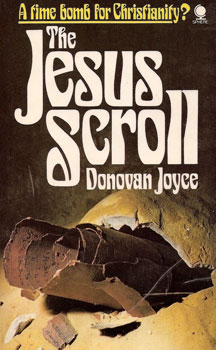The Jesus Scroll: Difference between revisions
AfD |
{{rescue}} |
||
| Line 2: | Line 2: | ||
{{AfDM|page=The Jesus Scroll|date=2008 March 26|substed=yes}} |
{{AfDM|page=The Jesus Scroll|date=2008 March 26|substed=yes}} |
||
<!-- For administrator use only: {{oldafdfull|page=The Jesus Scroll|date=26 March 2008|result='''keep'''}} --> |
<!-- For administrator use only: {{oldafdfull|page=The Jesus Scroll|date=26 March 2008|result='''keep'''}} --> |
||
{{rescue}} |
|||
<!-- End of AfD message, feel free to edit beyond this point --> |
<!-- End of AfD message, feel free to edit beyond this point --> |
||
Revision as of 08:49, 26 March 2008
An editor has nominated this article for deletion. You are welcome to participate in the deletion discussion, which will decide whether or not to retain it. |

The Jesus Scroll was a best-selling book first published in 1972 and written by Australian author Donovan Joyce. A forerunner to some of the ideas later investigated in The Da Vinci Code, Joyce's book made the claim that Jesus of Nazareth actually died in 70 AD at Masada in Israel during the Roman siege of that fortress.
Joyce, an Australian journalist, claimed to have seen a scroll stolen from the Masada excavations. He wrote that it was one of fifteen scrolls discovered during the dig there. His book states that the stolen autobiographical scroll was signed Yeshua ben Ya’akob ben Gennesareth, who described himself as eighty years old and added that he was the last of the rightful kings of Israel. The name when translated into English became Jesus of Gennesareth, son of Jacob.[1] Joyce identifies the author as Jesus of Nazareth. Joyce's book further claims that Jesus survived the crucifixion, was present during the Roman siege of Masada during the Jewish Revolt of 66-74 AD, and that he had married Mary Magdalene and fathered a child with her.
Joyce claimed that he attempted to visit Masada in 1964 during the archaeological excavation but was prevented by Yigael Yadin. Joyce further claimed that an anonymous and corrupt archaeologist asked him to smuggle the 'Jesus Scroll' out of Israel that had been discovered during that dig. Joyce says in his book that the scroll was taken from him at Tel Aviv airport by Israeli Security personnel and that it then probably disappeared into the Vatican Archive. He could offer no proof to support any of these claims. After publication of 'The Jesus Scroll' Yadin pointed out that only fragments of fourteen scrolls had been discovered at Masada, and no complete ones. Therefore, there was no fifteenth scroll.
Joyce researched the story of Jesus extensively, and proposed revolutionary theories concerning the historicity of the Jesus story that caused outrage among many Christians; indeed, Joyce received numerous death threats. Much of the book has been dismissed by many New Testament scholars and theologians as sheer speculation and suggestion, lacking any verifiable evidence.
"It was reassuring to discover that Jesus was a concerned human being with a truly Californian world-view" commented John Ray, Herbert Thompson Reader in Egyptology at the University of Cambridge, in 1991.[1]
Notes
- ^ The Times Literary Supplement, May 24, 1991.
References
- The Jesus Scroll by Donovan Joyce. Published by Sphere (1975)
